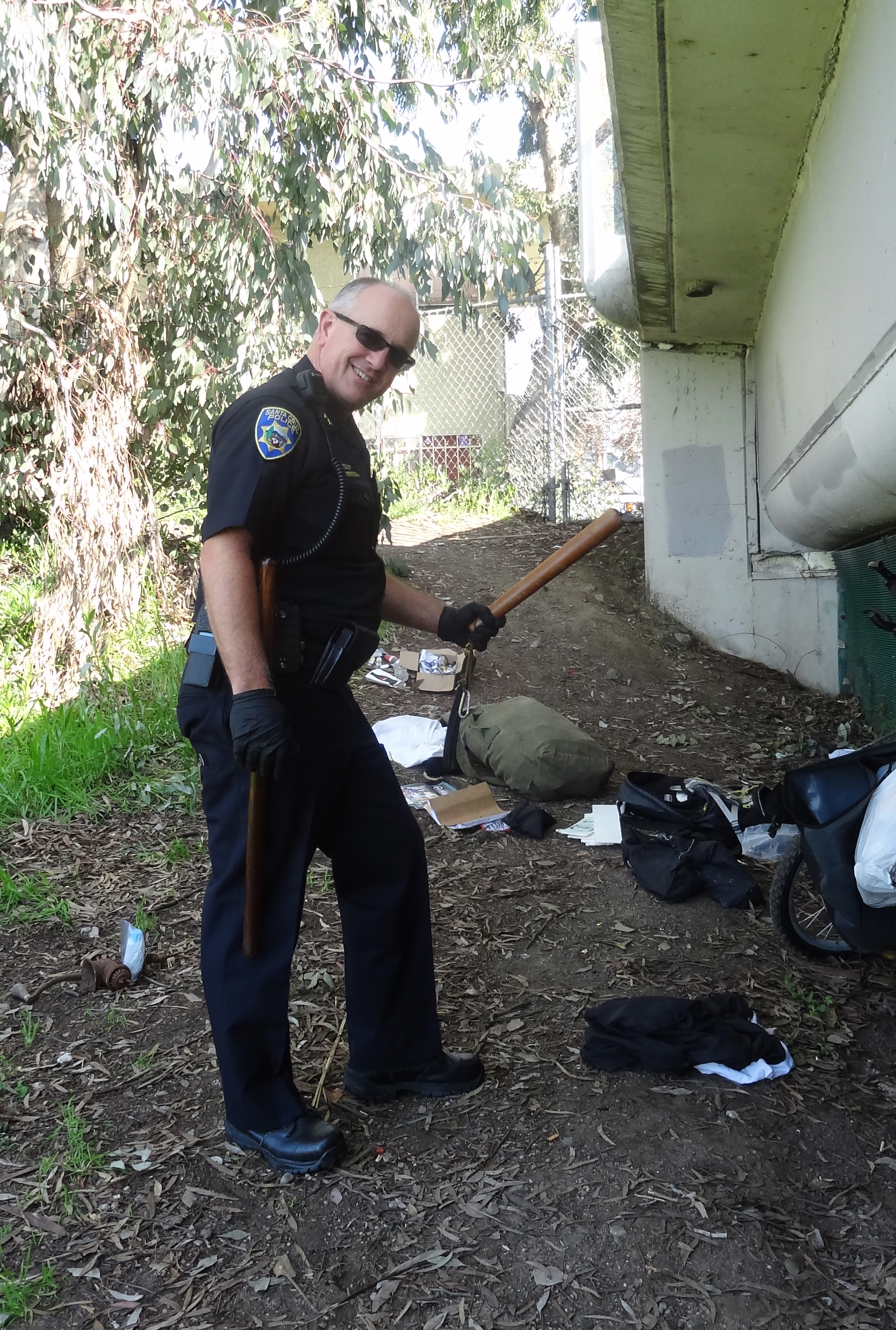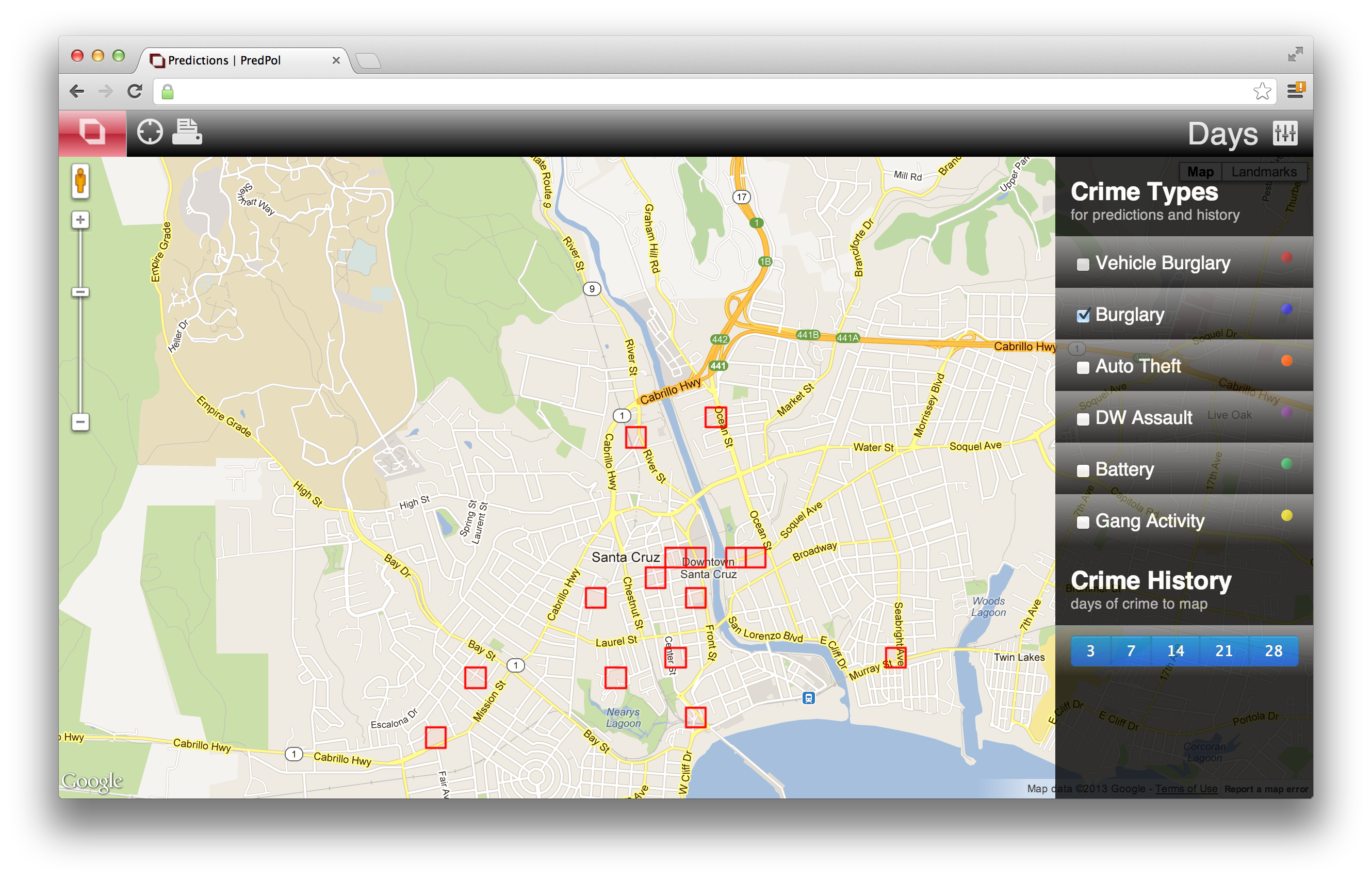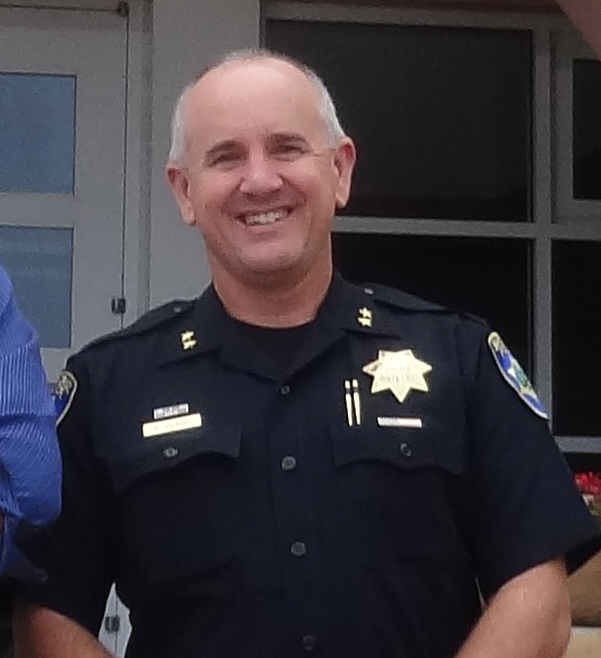How Predictive Policing Is Using Algorithms to Deliver Crime-Reduction Results for Cities

The Santa Cruz Boardwalk as seen at night. jared ropelato / Shutterstock.com
From its birth in Santa Cruz, California, advancing technology allows better deployment of police resources in departments across the nation.
SANTA CRUZ, Calif. — We were cruising the streets in Deputy Police Chief Steve Clark’s Crown Victoria, looking for anomalies in the patterns of life in this renowned beach town 75 miles south of San Francisco, home to generations of surfers and a legendary boardwalk complete with roller coaster and countless arcade games.
There didn’t seem to be much crime in the middle of a nice day in mid-February. But then another patrol car reported in. We drove to join other cops alongside a canal where drug users sometimes congregate.

Under a desolate bridge was a thin man with a trim buzz cut sitting amid his few possessions—bicycle, knapsack, not much else—and a scattered array of needles and other drug paraphernalia. He had begun painting graffiti on the side of the overpass, police said. They had found a dangerous cudgel concealed in the suspect's pack, shown in this photo at left of the deputy chief at the scene.
The suspect was destined for jail that night.
As it happened, the deputy chief told me, the alleged offender was discovered in a PredPol box, a 500-by-500 yard area identified by software the department has been using to predict where crime might happen each day during each of three shifts.
Coincidence? Too good to be true when the software targets only 15 of these half-block areas in a city covering about 16 square miles?
As physicist Niels Bohr observed, it’s very difficult to see into the future, but Santa Cruz and dozens of other American cities are using predictive technology to guide the work of their policemen. Slowly, the technology has taken hold, gradually winning converts amid “prove-it-to-me” skepticism that the crystal ball really works. But if it does work, and advocates do have statistics to make their case, the technology can bring badly needed efficiencies to police departments whose budgets are static or shrinking but whose workload is often on the rise.
California Creation
Santa Cruz and Los Angeles are among the first cities to try out predictive policing. That’s because the technology was developed by two California professors: UCLA anthropologist Jeffrey Brantingham and Santa Clara University computer science and mathematics professor George Mohler. Their algorithm, built on both mathematical and human behavioral foundations, is the guts of the PredPol crystal ball.
Santa Cruz is also home to the company that has the rights to the professors’ algorithm. It calls itself “PredPol, The Predictive Policing Company,” and in the still-small marketplace for predictive software, it is the market leader. Over breakfast, company president Larry Samuels talked about the challenges of building a company whose product must overcome not only skepticism but also cultural barriers and the 12- to 18-month procurement cycles typical of the public sector. PredPol has yet to turn a profit.
So how does it work?

Samuels, pictured here, began by emphasizing that cops know their beats, know where crime tends to happen in any city. We talked about longstanding police statistics-gathering programs like CompStat in New York City, grandfather of them all.
CompStat can pinpoint where crime has occurred every day, and it has served as a guide to assignments of police officers in New York and in many other cities that have emulated New York’s system. But as a tool for using the past to predict the future, CompStat lacks a degree of sophistication.
PredPol uses millions of reports, stretching back over years, to make its predictions, said Samuels. It can be programmed to focus on categories of crimes such as auto thefts, auto break-ins, burglaries and more. Time of day is obviously important, as are other factors.

Of 20 possible half-block areas, the first three are well known to police on the beat, Samuels observed. (An example of PredPol boxes in Santa Cruz are pictured above in a company-provided image.) Numbers four through seven are a bit less certain, for instance rising or falling according to the day of the week and the time of day. And beyond that, there’s little or no ready knowledge about where crime might be likely to strike.
Deputy Chief Clark (no relation to this writer) too emphasized that his 94 sworn officers and six community policing staff are charged with knowing their beats. But he instructs patrols to use their downtime—perhaps 15 to 20 minutes between incident calls—to visit one of the 15 PredPol boxes displayed on their vehicle computers.
The technology has had favorable treatment in the media. Setting the tone for subsequent coverage across the nation, The New York Times in August 2011, attributed arrests in Santa Cruz to police presence directed by PredPol, headlining the story “Sending the Police Before There’s a Crime.” And Time magazine anointed PredPol as one of the top 50 inventions of 2011.
In fact, the technology had been in development for several years, but Samuels said his company wasn’t positioned to take advantage of the 2011 media windfall. At the time run by academics and former cops, it was lacking in executive and marketing talent. Samuels became CEO in January 2014, and only then did the company start to ramp up for serious expansion. Venture and angel-funded, PredPol now has 25 to 30 employees, Samuels said, and has sold some 60 software packages. Pricing starts at $10,000 and can go to $150,000 or beyond depending on the size of the community served.
Seeking Proof
A cautionary note about the technology was sounded by RAND Corp. in 2013. A study sponsored by the National Institute of Justice concluded:
- “Predictive Policing methods are not a crystal ball; they cannot foretell the future. They can only identify people and locations at increased risk of crime.
- “The operational value of predictive policing tools is in their contribution to broader law enforcement strategies that use the tools’ risk assessments to inform resource allocation and problem-solving decisions.
- “The collection and use of data on individuals has raised a number of concerns about privacy rights and civil liberties.”
PredPol’s algorithms, Samuels stressed, only consider information regarding time of day, crime types and crime locations going back a few years. They don’t factor in personal identifiable information nor do they profile individuals.
It’s a privacy line, Samuels said, the company doesn’t want to cross.
“PredPol Is Not ‘Minority Report,’” a piece of company promotional material is headlined, referring to the 2002 movie starring Tom Cruise where law enforcement uses a futuristic and aggressive predictive policing tool to apprehend criminals before crimes are committed.
And PredPol may not ever need to be “Minority Report.” Many police departments feel that PredPol’s current form is delivering results.
Researchers at RAND and elsewhere have searched for proof that the predictive technologies actually work to reduce crime. And in police department data, they’ve found positive outcomes.
The Atlanta Police Department, for example, conducted a 90-day pilot project in two of its six policing zones late in 2013. The test showed a marked decline in crime as compared with the previous year.
Atlanta magazine reported last November that “the Atlanta Police Department is ready to call PredPol a success.”
Norcross, Georgia, which deployed the software in August 2013, has seen a 20 percent decline in categories of crime analyzed by PredPol, according to the magazine. Atlanta police officials did not respond to requests for updated data.
Los Angeles Police Department Commander Sean Malinowski worked with the professors developing the PredPol software, and he deployed it in the LAPD’s Foothill Division in late 2011. Police data indicate that while property crimes stayed even in Los Angeles as a whole in 2012, the Foothill Division’s rate declined by 9 percent. PredPol deserves much of the credit, Malinowski told the local media at the time. Media coverage, as well as the RAND report, have raised concerns about the technology’s potential for racial profiling and affronts to privacy.
In an interview, Malinowski said that roughly half of the department’s 21 divisions are now using the technology. Blind testing like that done in 2012 has not been repeated, but property crimes of the type addressed by PredPol did show a decline of 4.6 percent from 2013 to 2014. More data about the technology’s effectiveness may come as LAPD patrol cars are equipped with GPS-enabled mini-iPads to automatically track “time in the box.” At a LAPD crime-fighters conference last week, Malinowski observed growing support among former skeptics of the technology.
Modesto, a city of 200,000 people in California’s Central Valley, has also seen positive results, The Modesto Bee reported in November. “This year, Modesto has had a 20 percent reduction in home burglaries, a 13 percent reduction in commercial thefts, a 12 percent reduction in vehicle thefts, an 11 percent reduction in robberies and a 5 percent reduction in larceny,” the Bee reported.
This came despite a 25 percent reduction in patrol staff and “hefty budget cuts,” Modesto Police Chief Galen Carroll said in a news release.
Other small cities that also report good results include Reading, Pennsylvania, and Hagerstown, Maryland.
Reading, which adopted the technology in October 2013, observed a 23 percent decline in burglaries in the next 12 months, the police department reported. “With almost 100,000 residents, we need to be doing everything we can to keep Reading residents safer,” Police Chief William Heim said in a recent statement. “We’ve lost over 45 officer positions due to financial constraints but have gained this invaluable tool.”
A Tool for Efficiency

In Santa Cruz, Deputy Chief Clark, pictured at right, said that budgetary pressures impact virtually every public sector agency in California. He said that although his staffing levels have stayed steady in the past few years, officers have seen their workloads increasing.
Violent crime has been on the rise in Santa Cruz, as prison-based gangs, the Norteños and Sureños, battle for control of narcotics and other illegal pursuits on the streets of the city. Police officer injuries sideline 12 to 15 percent of the force, Clark said, adding workload for the rest of the force.
Santa Cruz is also a highly popular destination among surfers, beach-goers, boardwalk-lovers, catering especially to the young, including students at the 25,000-strong campus of the UC Santa Cruz.
On any given day, Clark said, the city’s population of roughly 63,000 people can double. Especially at night, he said, “we see shootings, stabbings, fights, drugs and alcohol—a roving bar on the boardwalk.”

The city attracts tons of brown marijuana brought in by panga boats from Mexico, and also large quantities of methamphetamine.
With his force facing both growing workloads and losses from injuries, Clark has no choice but to seek more efficient policing, he said.
“The standard answer used to be, ‘I need more cops,’” he said. But that’s not in the cards today. So officers are no longer “just driving around” in downtime, but visiting one of the 15 PredPol boxes identifying possible crime sites.
Some of them don’t look like obvious venues for crime, but of course that is the point: finding crime in the not-so-obvious places.
Clark said that he has seen results. Auto theft in the first half of 2013 was up 42 percent from a year earlier. But then, with aid from the algorithm, police focused on the problem and ended the entire year with a 12 percent drop from 2012. Burglaries were up 5 percent in 2013, but down 24 percent in 2014. Straying from using the system can cause unwelcome spikes in crime, Clark said. His experience with PredPol has given him the confidence to begin a redesign of his officers’ beats, Clark added.
For Samuels, the challenge remains to convince more police departments that the company’s algorithm really works. Just like other software vendors, he faces continuing questions about return on investment in his system.
Samuels said he recognizes that it’s hard to prove that PredPol, as opposed to other factors, contributes to fewer burglaries, for example. But he is an effective proselyte, taking a broad view of what reducing crime can mean to communities.
“The ROI is phenomenal,” he said. “If you cut crime by 20 percent, you avoid countless hours officers must devote to paperwork. You lower the costs of incarceration, prosecution, victim losses and reductions in property values.” But, he adds, finding people who can take that broader view is not an easy task.
So as algorithms improve, and police departments test the technology, predictive policing remains a work in progress.
NEXT STORY: Texas Bill Would Block Federal Funds for Local Rail Transit Projects






